2017 NISSAN TITAN XD steering
[x] Cancel search: steeringPage 75 of 671
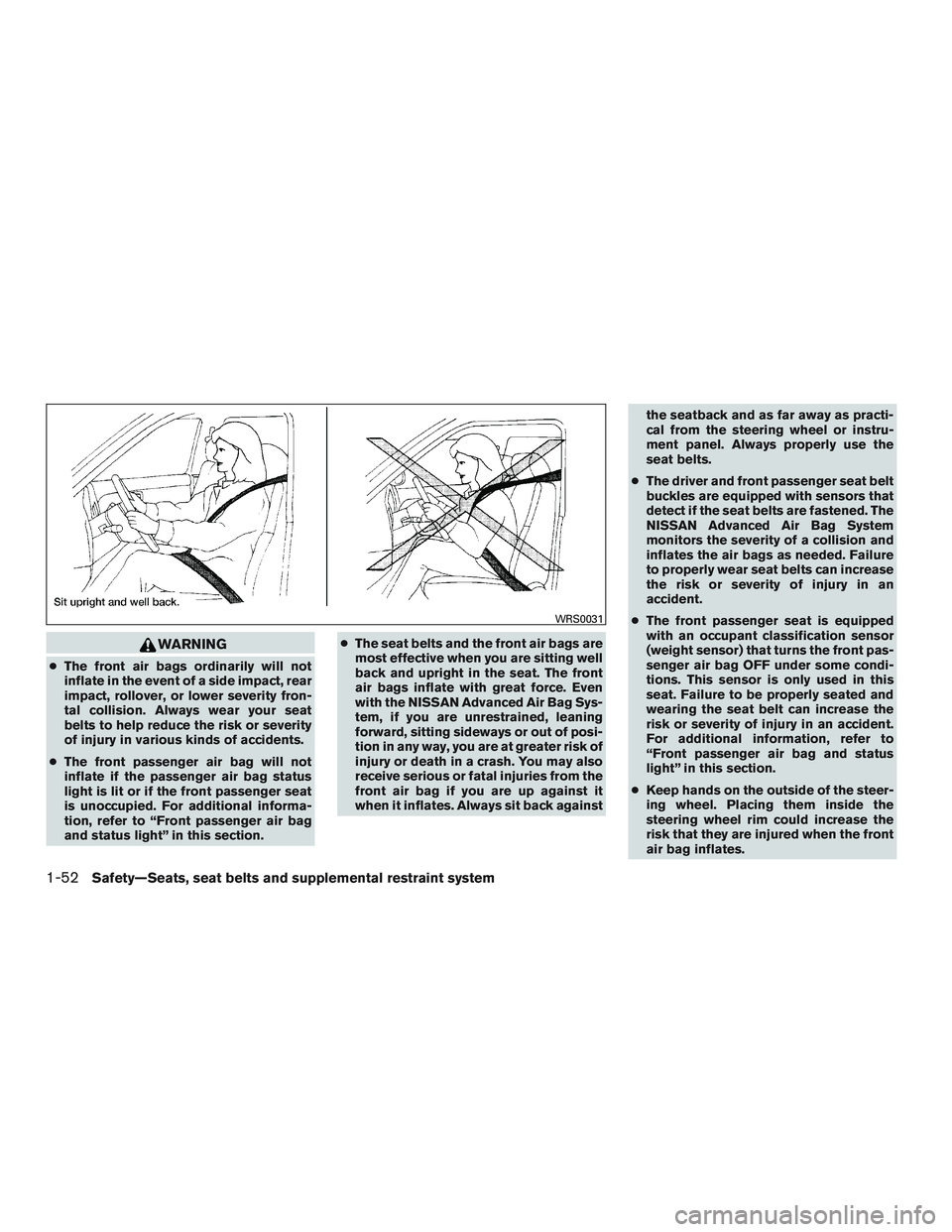
WARNING
●The front air bags ordinarily will not
inflate in the event of a side impact, rear
impact, rollover, or lower severity fron-
tal collision. Always wear your seat
belts to help reduce the risk or severity
of injury in various kinds of accidents.
● The front passenger air bag will not
inflate if the passenger air bag status
light is lit or if the front passenger seat
is unoccupied. For additional informa-
tion, refer to “Front passenger air bag
and status light” in this section. ●
The seat belts and the front air bags are
most effective when you are sitting well
back and upright in the seat. The front
air bags inflate with great force. Even
with the NISSAN Advanced Air Bag Sys-
tem, if you are unrestrained, leaning
forward, sitting sideways or out of posi-
tion in any way, you are at greater risk of
injury or death in a crash. You may also
receive serious or fatal injuries from the
front air bag if you are up against it
when it inflates. Always sit back against the seatback and as far away as practi-
cal from the steering wheel or instru-
ment panel. Always properly use the
seat belts.
● The driver and front passenger seat belt
buckles are equipped with sensors that
detect if the seat belts are fastened. The
NISSAN Advanced Air Bag System
monitors the severity of a collision and
inflates the air bags as needed. Failure
to properly wear seat belts can increase
the risk or severity of injury in an
accident.
● The front passenger seat is equipped
with an occupant classification sensor
(weight sensor) that turns the front pas-
senger air bag OFF under some condi-
tions. This sensor is only used in this
seat. Failure to be properly seated and
wearing the seat belt can increase the
risk or severity of injury in an accident.
For additional information, refer to
“Front passenger air bag and status
light” in this section.
● Keep hands on the outside of the steer-
ing wheel. Placing them inside the
steering wheel rim could increase the
risk that they are injured when the front
air bag inflates.
Page 82 of 671
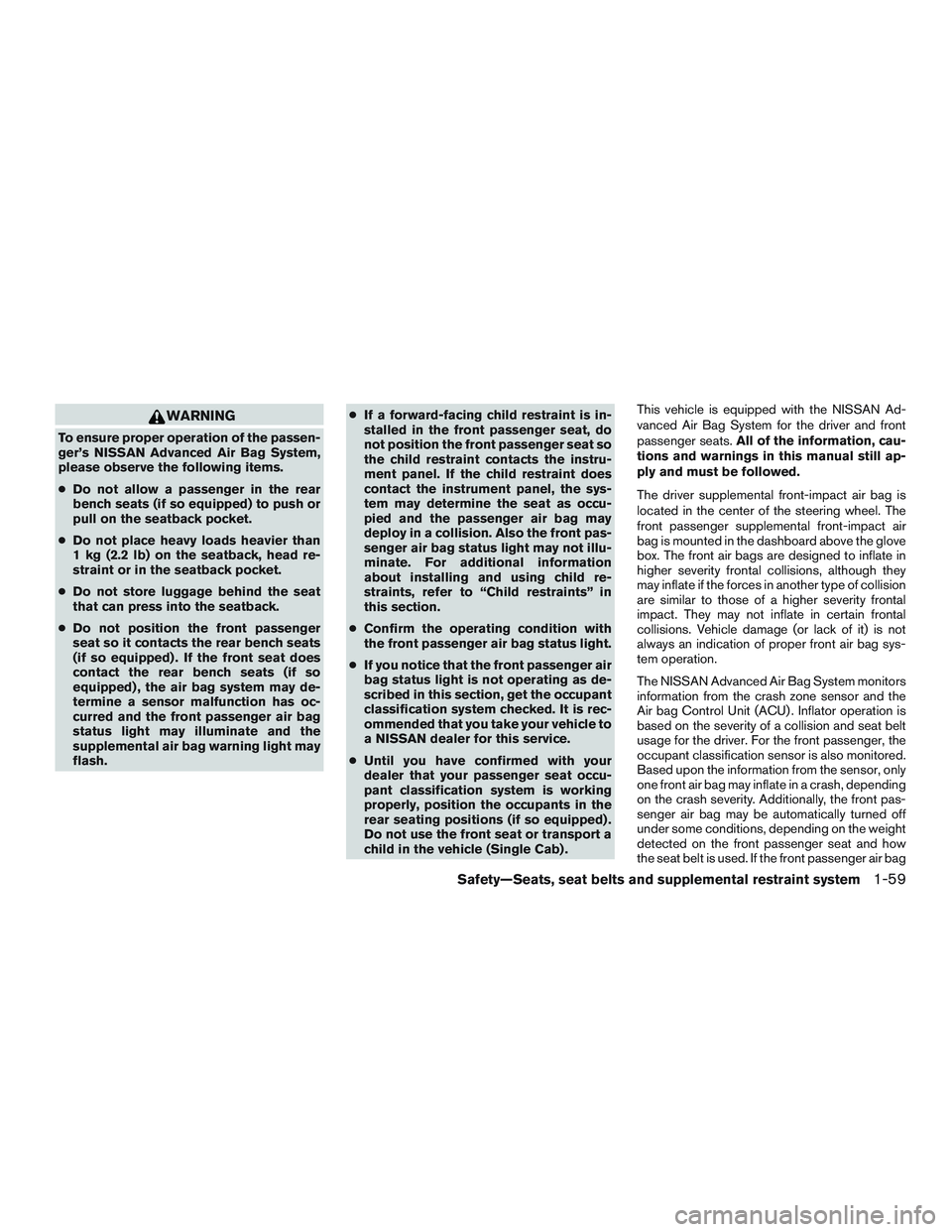
WARNING
To ensure proper operation of the passen-
ger’s NISSAN Advanced Air Bag System,
please observe the following items.
●Do not allow a passenger in the rear
bench seats (if so equipped) to push or
pull on the seatback pocket.
● Do not place heavy loads heavier than
1 kg (2.2 lb) on the seatback, head re-
straint or in the seatback pocket.
● Do not store luggage behind the seat
that can press into the seatback.
● Do not position the front passenger
seat so it contacts the rear bench seats
(if so equipped) . If the front seat does
contact the rear bench seats (if so
equipped) , the air bag system may de-
termine a sensor malfunction has oc-
curred and the front passenger air bag
status light may illuminate and the
supplemental air bag warning light may
flash. ●
If a forward-facing child restraint is in-
stalled in the front passenger seat, do
not position the front passenger seat so
the child restraint contacts the instru-
ment panel. If the child restraint does
contact the instrument panel, the sys-
tem may determine the seat as occu-
pied and the passenger air bag may
deploy in a collision. Also the front pas-
senger air bag status light may not illu-
minate. For additional information
about installing and using child re-
straints, refer to “Child restraints” in
this section.
● Confirm the operating condition with
the front passenger air bag status light.
● If you notice that the front passenger air
bag status light is not operating as de-
scribed in this section, get the occupant
classification system checked. It is rec-
ommended that you take your vehicle to
a NISSAN dealer for this service.
● Until you have confirmed with your
dealer that your passenger seat occu-
pant classification system is working
properly, position the occupants in the
rear seating positions (if so equipped) .
Do not use the front seat or transport a
child in the vehicle (Single Cab) . This vehicle is equipped with the NISSAN Ad-
vanced Air Bag System for the driver and front
passenger seats.
All of the information, cau-
tions and warnings in this manual still ap-
ply and must be followed.
The driver supplemental front-impact air bag is
located in the center of the steering wheel. The
front passenger supplemental front-impact air
bag is mounted in the dashboard above the glove
box. The front air bags are designed to inflate in
higher severity frontal collisions, although they
may inflate if the forces in another type of collision
are similar to those of a higher severity frontal
impact. They may not inflate in certain frontal
collisions. Vehicle damage (or lack of it) is not
always an indication of proper front air bag sys-
tem operation.
The NISSAN Advanced Air Bag System monitors
information from the crash zone sensor and the
Air bag Control Unit (ACU) . Inflator operation is
based on the severity of a collision and seat belt
usage for the driver. For the front passenger, the
occupant classification sensor is also monitored.
Based upon the information from the sensor, only
one front air bag may inflate in a crash, depending
on the crash severity. Additionally, the front pas-
senger air bag may be automatically turned off
under some conditions, depending on the weight
detected on the front passenger seat and how
the seat belt is used. If the front passenger air bag
Safety—Seats, seat belts and supplemental restraint system1-59
Page 83 of 671
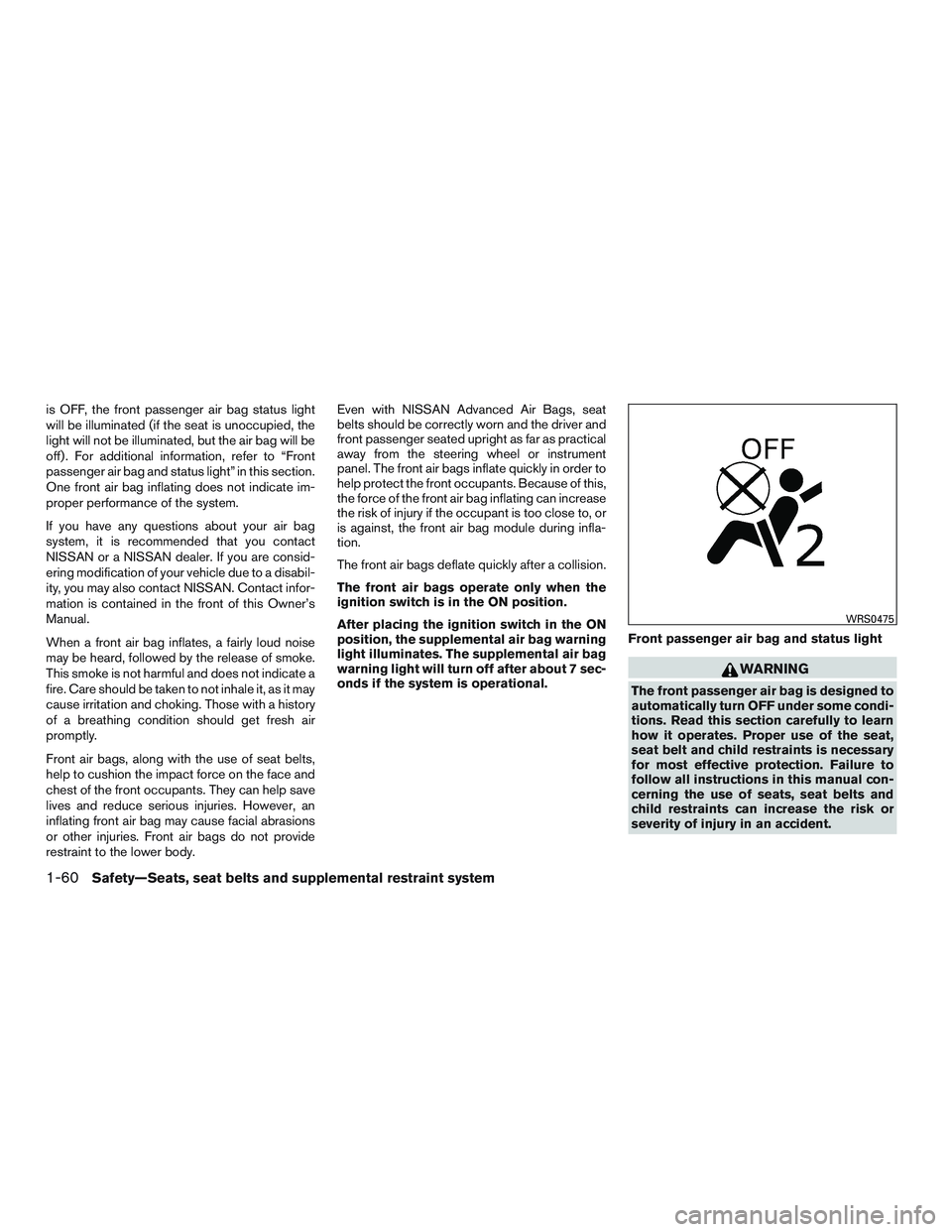
is OFF, the front passenger air bag status light
will be illuminated (if the seat is unoccupied, the
light will not be illuminated, but the air bag will be
off) . For additional information, refer to “Front
passenger air bag and status light” in this section.
One front air bag inflating does not indicate im-
proper performance of the system.
If you have any questions about your air bag
system, it is recommended that you contact
NISSAN or a NISSAN dealer. If you are consid-
ering modification of your vehicle due to a disabil-
ity, you may also contact NISSAN. Contact infor-
mation is contained in the front of this Owner’s
Manual.
When a front air bag inflates, a fairly loud noise
may be heard, followed by the release of smoke.
This smoke is not harmful and does not indicate a
fire. Care should be taken to not inhale it, as it may
cause irritation and choking. Those with a history
of a breathing condition should get fresh air
promptly.
Front air bags, along with the use of seat belts,
help to cushion the impact force on the face and
chest of the front occupants. They can help save
lives and reduce serious injuries. However, an
inflating front air bag may cause facial abrasions
or other injuries. Front air bags do not provide
restraint to the lower body.Even with NISSAN Advanced Air Bags, seat
belts should be correctly worn and the driver and
front passenger seated upright as far as practical
away from the steering wheel or instrument
panel. The front air bags inflate quickly in order to
help protect the front occupants. Because of this,
the force of the front air bag inflating can increase
the risk of injury if the occupant is too close to, or
is against, the front air bag module during infla-
tion.
The front air bags deflate quickly after a collision.
The front air bags operate only when the
ignition switch is in the ON position.
After placing the ignition switch in the ON
position, the supplemental air bag warning
light illuminates. The supplemental air bag
warning light will turn off after about 7 sec-
onds if the system is operational.
Front passenger air bag and status light
Page 89 of 671
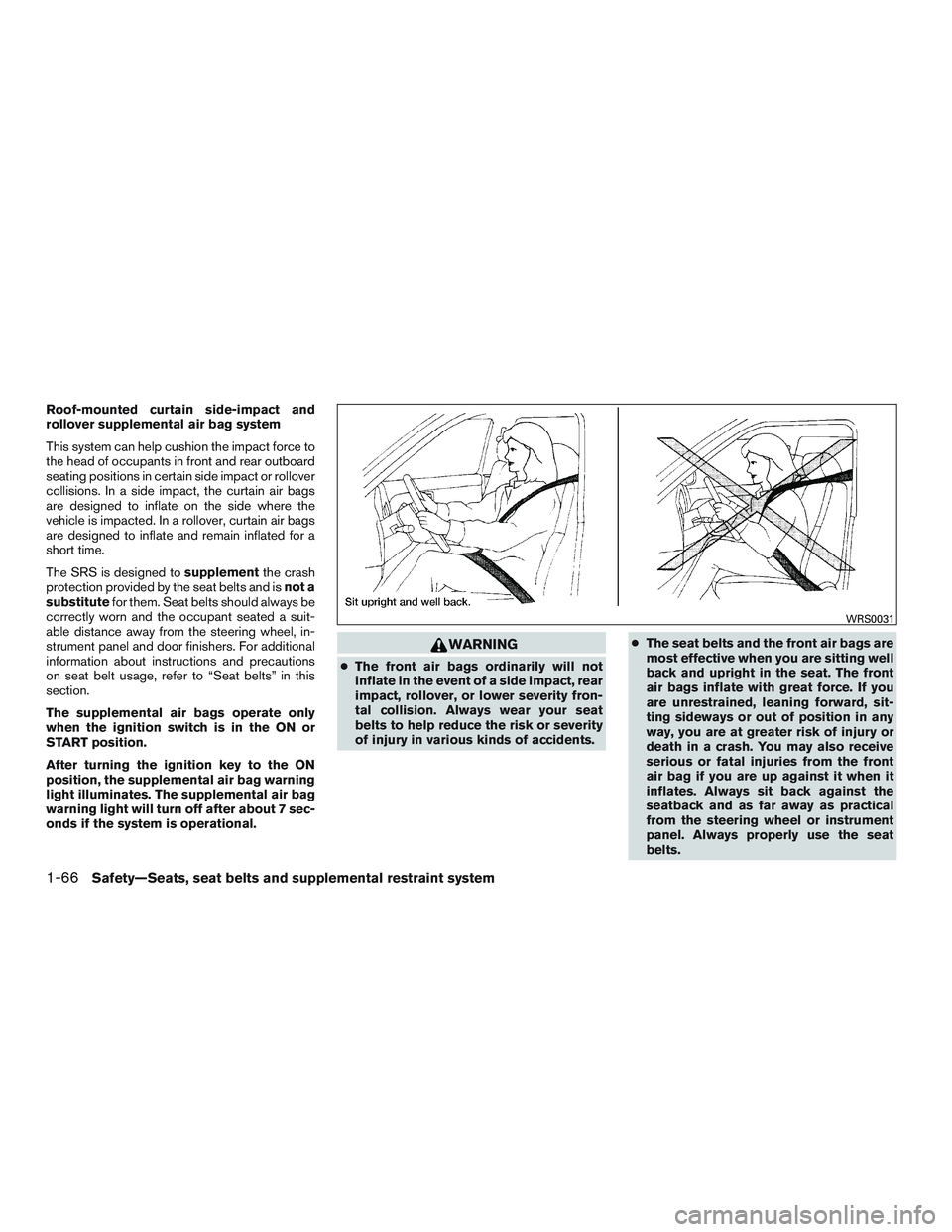
Roof-mounted curtain side-impact and
rollover supplemental air bag system
This system can help cushion the impact force to
the head of occupants in front and rear outboard
seating positions in certain side impact or rollover
collisions. In a side impact, the curtain air bags
are designed to inflate on the side where the
vehicle is impacted. In a rollover, curtain air bags
are designed to inflate and remain inflated for a
short time.
The SRS is designed tosupplementthe crash
protection provided by the seat belts and is not a
substitute for them. Seat belts should always be
correctly worn and the occupant seated a suit-
able distance away from the steering wheel, in-
strument panel and door finishers. For additional
information about instructions and precautions
on seat belt usage, refer to “Seat belts” in this
section.
The supplemental air bags operate only
when the ignition switch is in the ON or
START position.
After turning the ignition key to the ON
position, the supplemental air bag warning
light illuminates. The supplemental air bag
warning light will turn off after about 7 sec-
onds if the system is operational.
Page 90 of 671
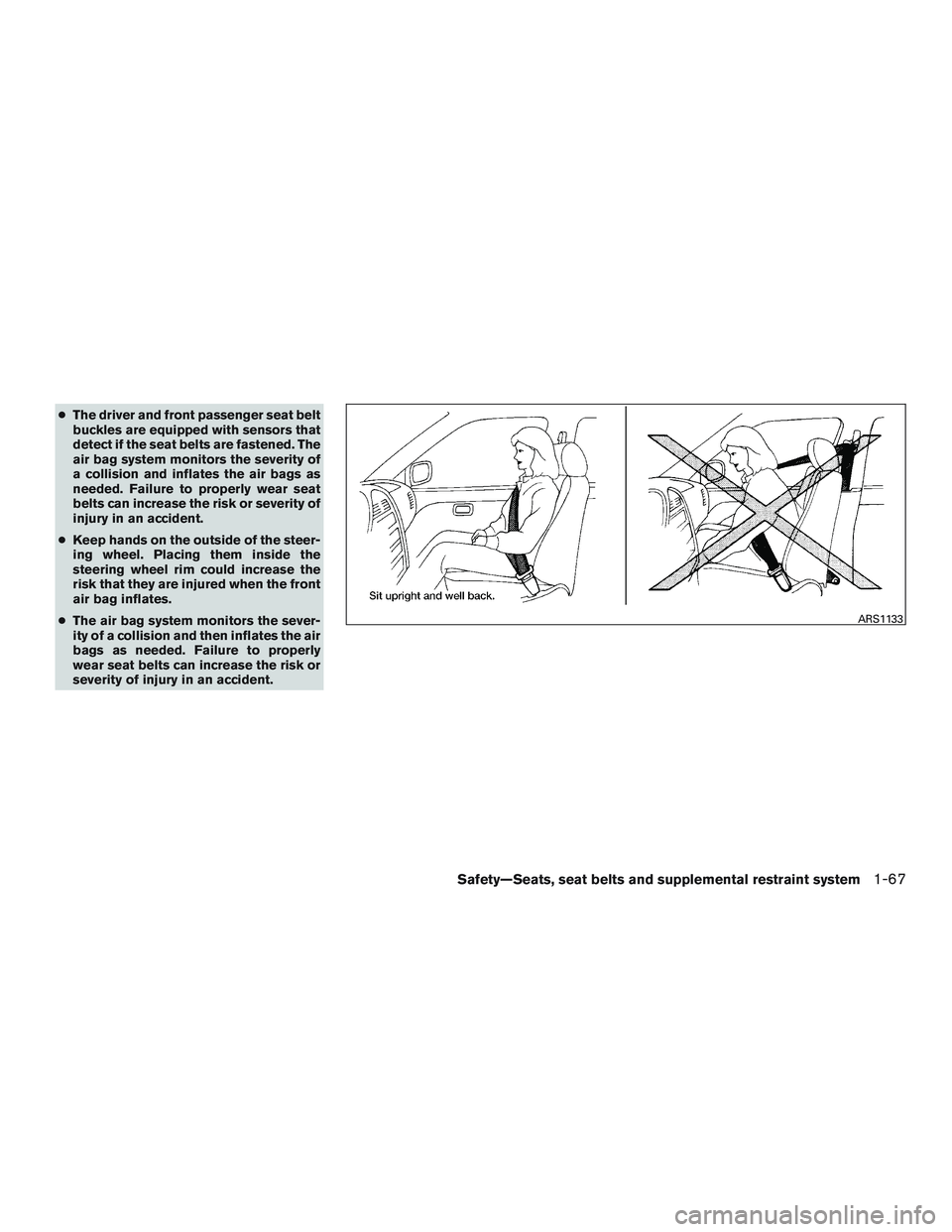
●The driver and front passenger seat belt
buckles are equipped with sensors that
detect if the seat belts are fastened. The
air bag system monitors the severity of
a collision and inflates the air bags as
needed. Failure to properly wear seat
belts can increase the risk or severity of
injury in an accident.
● Keep hands on the outside of the steer-
ing wheel. Placing them inside the
steering wheel rim could increase the
risk that they are injured when the front
air bag inflates.
● The air bag system monitors the sever-
ity of a collision and then inflates the air
bags as needed. Failure to properly
wear seat belts can increase the risk or
severity of injury in an accident.
Page 96 of 671
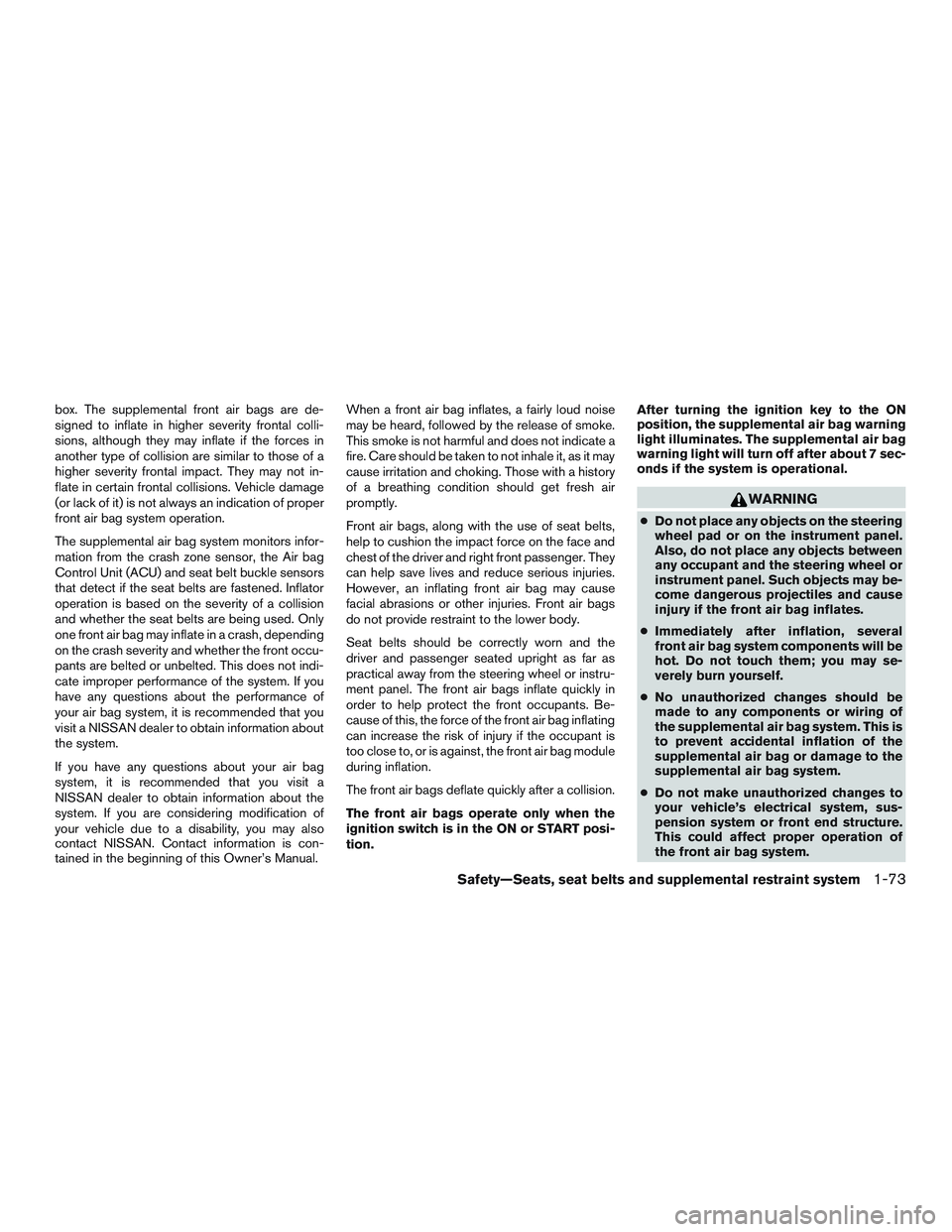
box. The supplemental front air bags are de-
signed to inflate in higher severity frontal colli-
sions, although they may inflate if the forces in
another type of collision are similar to those of a
higher severity frontal impact. They may not in-
flate in certain frontal collisions. Vehicle damage
(or lack of it) is not always an indication of proper
front air bag system operation.
The supplemental air bag system monitors infor-
mation from the crash zone sensor, the Air bag
Control Unit (ACU) and seat belt buckle sensors
that detect if the seat belts are fastened. Inflator
operation is based on the severity of a collision
and whether the seat belts are being used. Only
one front air bag may inflate in a crash, depending
on the crash severity and whether the front occu-
pants are belted or unbelted. This does not indi-
cate improper performance of the system. If you
have any questions about the performance of
your air bag system, it is recommended that you
visit a NISSAN dealer to obtain information about
the system.
If you have any questions about your air bag
system, it is recommended that you visit a
NISSAN dealer to obtain information about the
system. If you are considering modification of
your vehicle due to a disability, you may also
contact NISSAN. Contact information is con-
tained in the beginning of this Owner’s Manual.When a front air bag inflates, a fairly loud noise
may be heard, followed by the release of smoke.
This smoke is not harmful and does not indicate a
fire. Care should be taken to not inhale it, as it may
cause irritation and choking. Those with a history
of a breathing condition should get fresh air
promptly.
Front air bags, along with the use of seat belts,
help to cushion the impact force on the face and
chest of the driver and right front passenger. They
can help save lives and reduce serious injuries.
However, an inflating front air bag may cause
facial abrasions or other injuries. Front air bags
do not provide restraint to the lower body.
Seat belts should be correctly worn and the
driver and passenger seated upright as far as
practical away from the steering wheel or instru-
ment panel. The front air bags inflate quickly in
order to help protect the front occupants. Be-
cause of this, the force of the front air bag inflating
can increase the risk of injury if the occupant is
too close to, or is against, the front air bag module
during inflation.
The front air bags deflate quickly after a collision.
The front air bags operate only when the
ignition switch is in the ON or START posi-
tion.
After turning the ignition key to the ON
position, the supplemental air bag warning
light illuminates. The supplemental air bag
warning light will turn off after about 7 sec-
onds if the system is operational.
Page 97 of 671
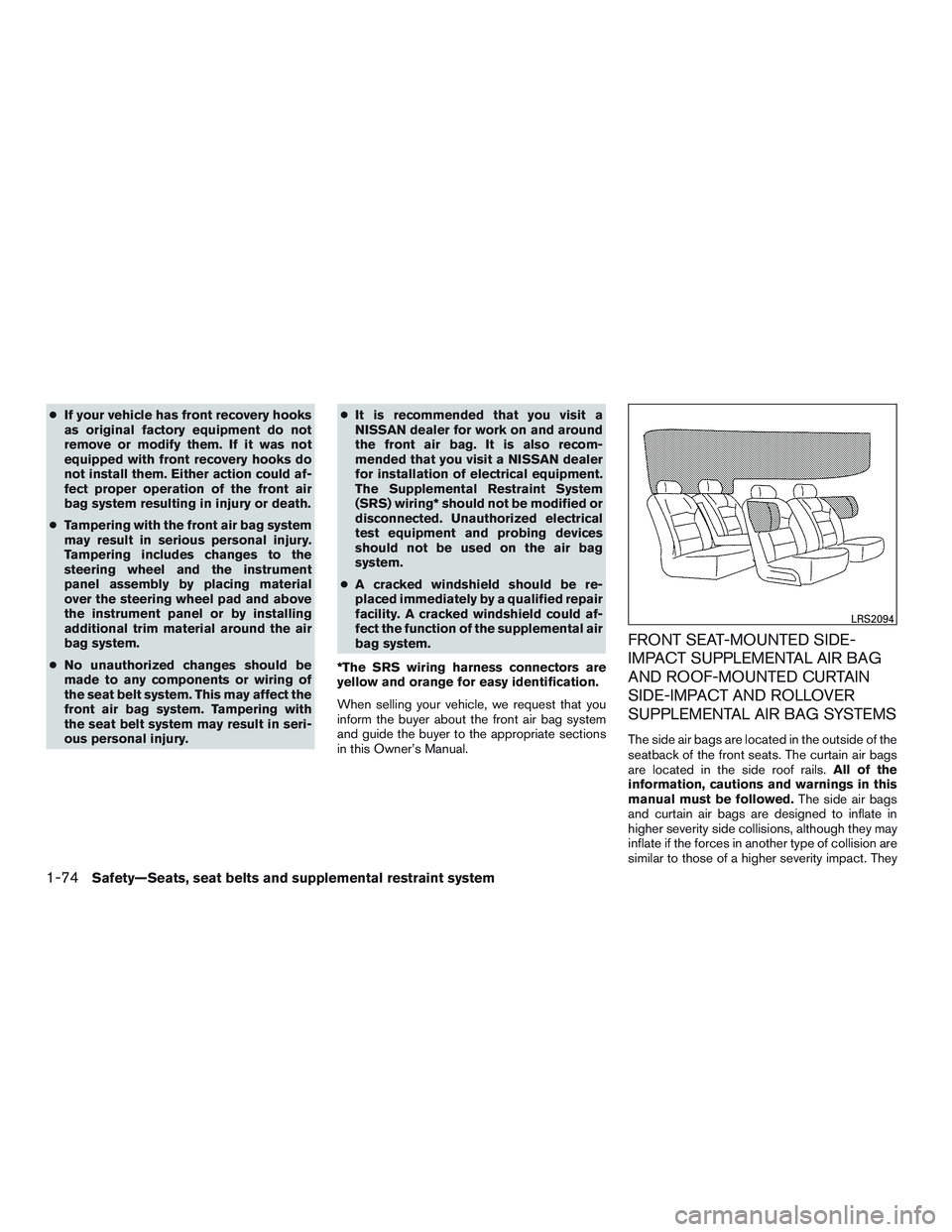
●If your vehicle has front recovery hooks
as original factory equipment do not
remove or modify them. If it was not
equipped with front recovery hooks do
not install them. Either action could af-
fect proper operation of the front air
bag system resulting in injury or death.
● Tampering with the front air bag system
may result in serious personal injury.
Tampering includes changes to the
steering wheel and the instrument
panel assembly by placing material
over the steering wheel pad and above
the instrument panel or by installing
additional trim material around the air
bag system.
● No unauthorized changes should be
made to any components or wiring of
the seat belt system. This may affect the
front air bag system. Tampering with
the seat belt system may result in seri-
ous personal injury. ●
It is recommended that you visit a
NISSAN dealer for work on and around
the front air bag. It is also recom-
mended that you visit a NISSAN dealer
for installation of electrical equipment.
The Supplemental Restraint System
(SRS) wiring* should not be modified or
disconnected. Unauthorized electrical
test equipment and probing devices
should not be used on the air bag
system.
● A cracked windshield should be re-
placed immediately by a qualified repair
facility. A cracked windshield could af-
fect the function of the supplemental air
bag system.
*The SRS wiring harness connectors are
yellow and orange for easy identification.
When selling your vehicle, we request that you
inform the buyer about the front air bag system
and guide the buyer to the appropriate sections
in this Owner’s Manual.
FRONT SEAT-MOUNTED SIDE-
IMPACT SUPPLEMENTAL AIR BAG
AND ROOF-MOUNTED CURTAIN
SIDE-IMPACT AND ROLLOVER
SUPPLEMENTAL AIR BAG SYSTEMS
The side air bags are located in the outside of the
seatback of the front seats. The curtain air bags
are located in the side roof rails. All of the
information, cautions and warnings in this
manual must be followed. The side air bags
and curtain air bags are designed to inflate in
higher severity side collisions, although they may
inflate if the forces in another type of collision are
similar to those of a higher severity impact. They
Page 161 of 671
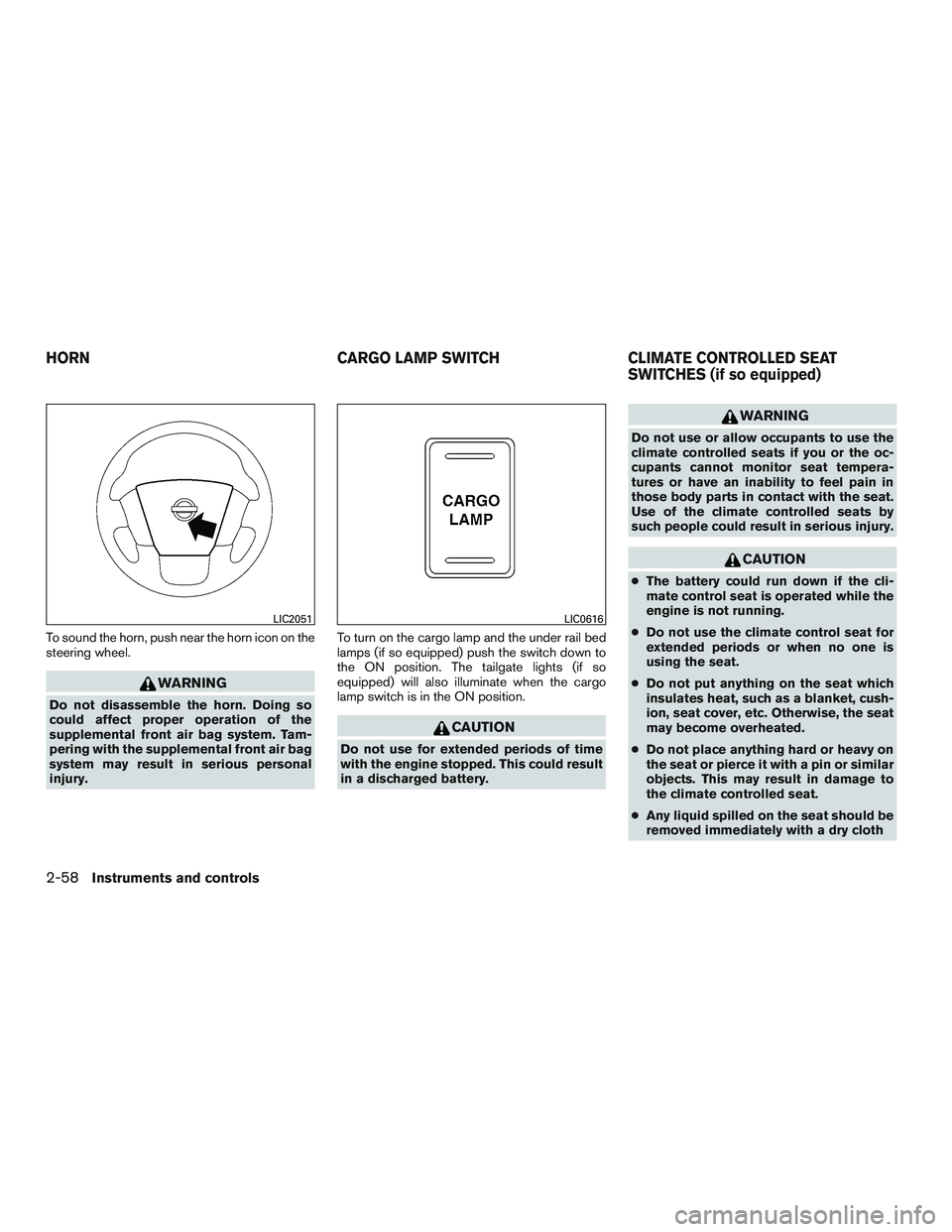
To sound the horn, push near the horn icon on the
steering wheel.